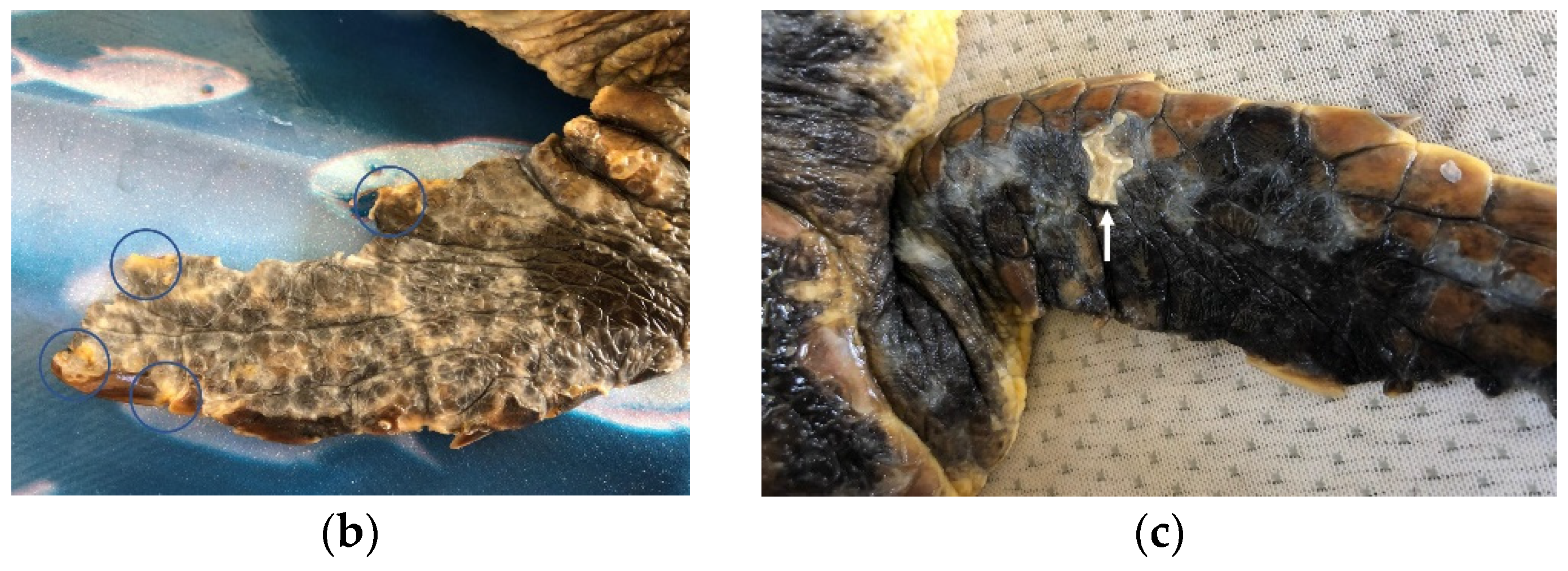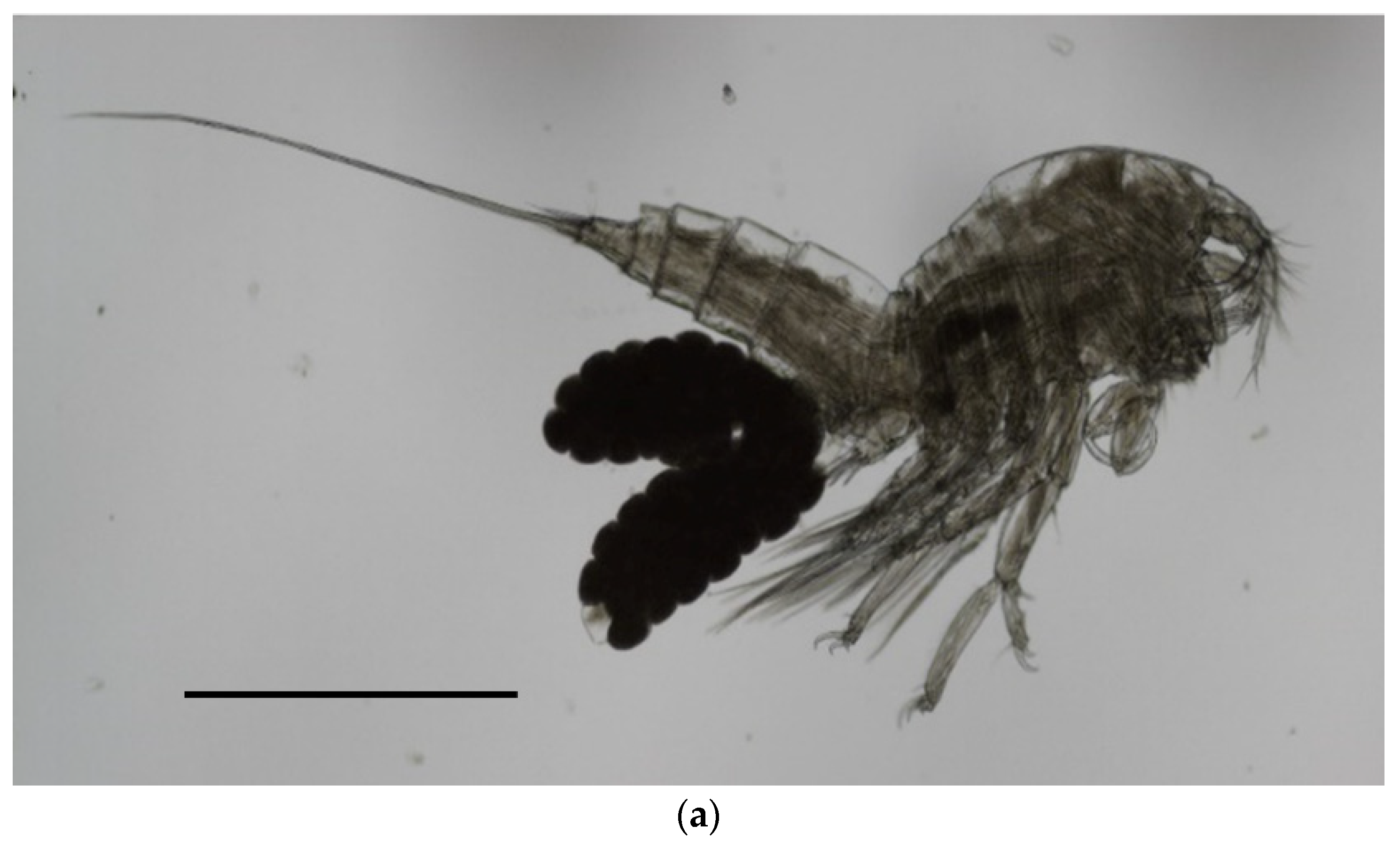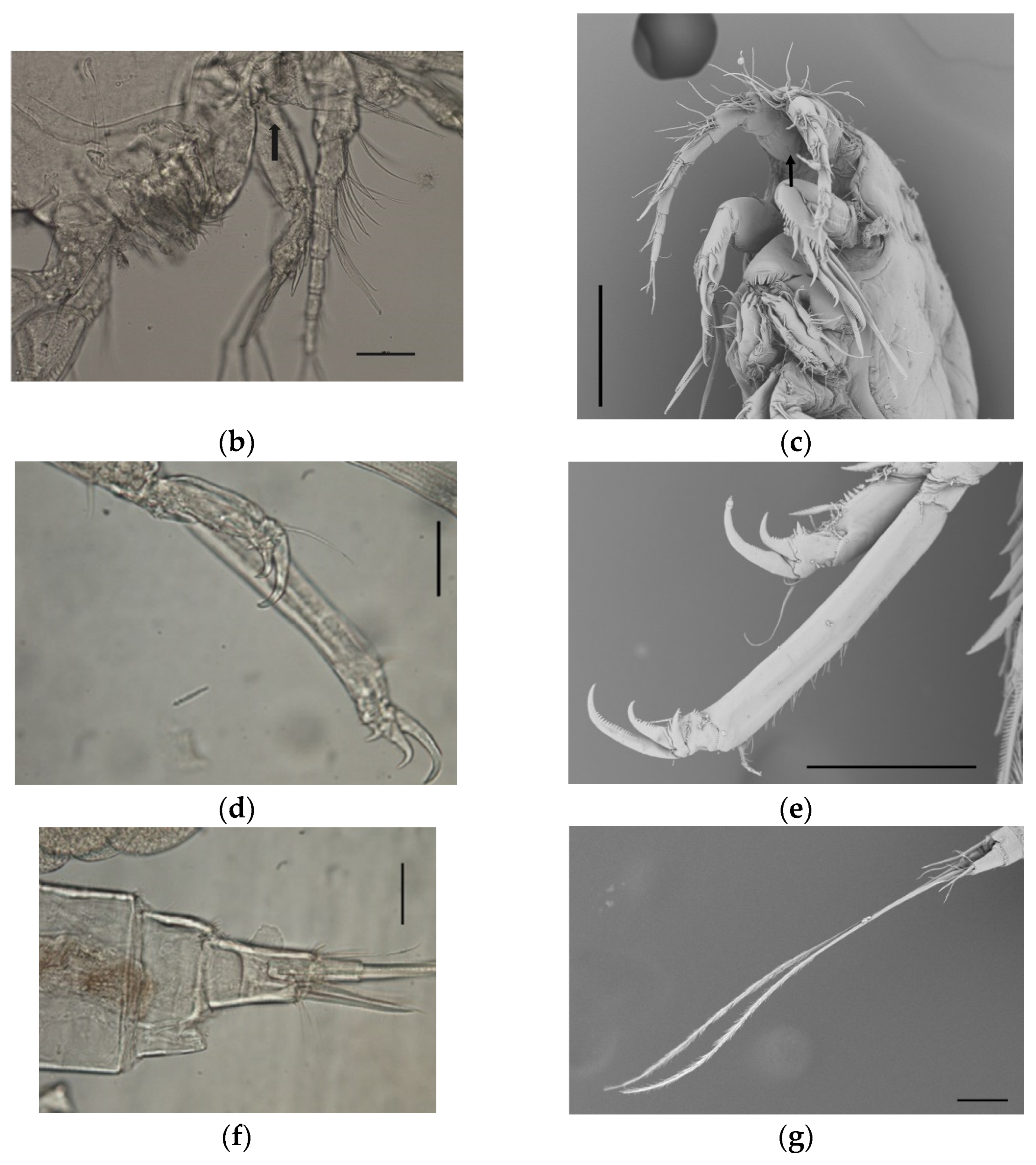Balaenophilus manatorum in Debilitated and Bycatch-Derived Loggerhead Sea Turtles Caretta caretta from Northwestern Adriatic Sea
Abstract
Simple Summary
Abstract
1. Introduction
2. Materials and Methods
2.1. Clinical Data Collection
2.2. Parasitological Analyses
2.3. Data Analysis
3. Results
3.1. Clinical Data
3.2. Parasitological Examination
4. Discussion
5. Conclusions
Supplementary Materials
Author Contributions
Funding
Institutional Review Board Statement
Informed Consent Statement
Data Availability Statement
Acknowledgments
Conflicts of Interest
References
- Lucchetti, A.; Pulcinella, J.; Angelini, V.; Pari, S.; Russo, T.; Cataudella, S. An interaction index to predict turtle bycatch in a Mediterranean bottom trawl fishery. Ecol. Indic. 2016, 60, 557–564. [Google Scholar] [CrossRef]
- Stacy, N.I.; Lynch, J.M.; Arendt, M.D.; Avens, L.; Braun McNeill, J.; Cray, C.; Day, R.D.; Harms, C.A.; Lee, A.M.; Peden-Adams, M.M.; et al. Chronic debilitation in stranded loggerhead sea turtles (Caretta caretta) in the southeastern United States: Morphometrics and clinicopathological findings. PLoS ONE 2018, 113, e0200355. [Google Scholar] [CrossRef] [PubMed]
- Manire, C.A.; Stacy, N.I.; Norton, T.M. Chronic debilitation. In Sea Turtle Medicine and Rehabilitation; Manire, C.A., Norton, T.M., Stacy, B.A., Innis, C.J., Harms, C.A., Eds.; J. Ross Publishing: Plantation, FL, USA, 2017; pp. 707–724. [Google Scholar]
- Deem, S.L.; Norton, T.M.; Mitchell, M.; Segars, A.; Alleman, A.R.; Cray, C.; Poppenga, R.H.; Dodd, M.; Karesh, W.B. Comparison of blood values in foraging, nesting, and stranded loggerhead turtles (Caretta caretta) along the coast of Georgia, USA. J. Wildl. Dis. 2009, 45, 41–56. [Google Scholar] [CrossRef] [PubMed]
- Flint, M.; Patterson-Kane, J.C.; Limpus, C.J.; Work, T.M.; Blair, D.; Mills, P.C. Postmortem Diagnostic Investigation of Disease in Free-Ranging Marine Turtle Populations: A Review of Common Pathologic Findings and Protocols. J. Vet. Diagn. Investig. 2009, 21, 733–759. [Google Scholar] [CrossRef] [PubMed]
- Nolte, C.R.; Nel, R.; Pfaff, M.C. Determining body condition of nesting loggerhead sea turtles (Caretta caretta) in the South-west Indian Ocean. J. Mar. Biol. Assoc. U. K. 2020, 100, 291–299. [Google Scholar] [CrossRef]
- Schofield, G.; Katselidis, K.A.; Dimopoulos, P.; Pantis, J.D.; Hays, G.C. Behavioural analysis of loggerhead sea turtle Caretta caretta from direct in-water observation. Endang. Species Res. 2006, 2, 71–79. [Google Scholar] [CrossRef]
- Losey, G.S.; Balazs, G.H.; Privitera, L.A. Cleaning Symbiosis between the Wrasse, Thalassoma duperry, and the Green Turtle, Chelonia mydas. Copeia 1994, 3, 684–690. [Google Scholar] [CrossRef]
- Seigel, R.A. Occurrence and Effects of Barnacle Infestations on Diamondback Terrapins (Malaclemys terrapin). Am. Mid. Nat. 1983, 109, 34–39. [Google Scholar] [CrossRef]
- Wells, J.B.J. An Annotated Checklist and Keys to the Species of Copepod a Harpacticoida (Crustacea); Zootaxa Series, 1568; Magnolia Press: Auckland, New Zealand, 2007; pp. 1–872. [Google Scholar]
- Rossel, S.; Martínez Arbizu, P. Revealing higher than expected diversity of Harpacticoida (Crustacea:Copepoda) in the North Sea using MALDI-TOF MS and molecular barcoding. Sci. Rep. 2019, 9, 9182. [Google Scholar] [CrossRef]
- Badillo, F.J.; Puig, L.; Montero, F.E.; Raga, J.A.; Aznar, F.J. Diet of Balaenophilus spp. (Copepoda: Harpacticoida): Feeding on keratin at sea? Mar. Biol. 2007, 151, 751–758. [Google Scholar] [CrossRef]
- Crespo-Picazo, J.L.; García-Parraga, D.; Domènech, F.; Tomás, J.; Aznar, F.J.; Ortega, J.; Corpa, J.M. Parasitic outbreak of the copepod Balaenophilus manatorum in neonate loggerhead sea turtles (Caretta caretta) from a head-starting program. BMC Vet. Res. 2017, 13, 154. [Google Scholar] [CrossRef] [PubMed]
- LafeberVet Web Site, Body Condition Scoring the Sea Turtle. Available online: https://lafeber.com/vet/body-condition-scoring-the-sea-turtle/ (accessed on 8 March 2023).
- Stacy, N.I.; Alleman, A.R.; Sayler, K.A. Diagnostic Hematology of Reptiles. Clin. Lab. Med. 2011, 31, 87–108. [Google Scholar] [CrossRef] [PubMed]
- Stacy, N.I.; Innis, C.J. Clinical Pathology. In Sea Turtle Medicine and Rehabilitation; Manire, C.A., Norton, T.M., Stacy, B.A., Innis, C.J., Harms, C.A., Eds.; J. Ross Publishing: Plantation, FL, USA, 2017; pp. 147–207. [Google Scholar]
- Casal, A.B.; Orós, J. Plasma biochemistry and haematology values in juvenile loggerhead sea turtles undergoing rehabilitation. Vet. Rec. 2009, 164, 663–665. [Google Scholar] [CrossRef]
- Tedesco, P.; Gustinelli, A.; Caffara, M.; Patarnello, P.; Terlizzi, A.; Fioravanti, M.L. Hysterothylacium fabri (Nematoda: Raphidascarididae) in Mullus surmuletus (Perciformes: Mullidae) and Uranoscopus scaber (Perciformes: Uranoscopidae) from the Mediterranean. J. Parasitol. 2018, 104, 262–274. [Google Scholar] [CrossRef]
- Aznar, F.J.; Badillo, F.J.; Mateu, P.; Raga, J.A. Balaenophilus manatorum (Ortíz, Lalana and Torres, 1992) (Copepoda: Harpacticoida) from loggerhead sea turtles, Caretta caretta, from Japan and the western Mediterranean: Amended description and geographical comparison. J. Parasitol. 2010, 96, 299–307. [Google Scholar] [CrossRef]
- Ogawa, K.; Matsuzaki, K.; Misaki, H. A new species of Balaenophilus (Copepoda: Harpacticoida), an ectoparasite of a sea turtle in Japan. Zool. Sci. 1997, 14, 691–699. [Google Scholar] [CrossRef]
- Relini, G. Cirripedi Toracici. Guide per il Risonoscimento delle Specie Animali Acque Lagunari e Costiere Italiane; Consiglio Nazionale delle Recherche: Genova, Italy, 1980; p. 112. [Google Scholar]
- Bush, A.O.; Lafferty, K.D.; Lotz, J.M.; Shostak, A.W. Parasitology meets ecology on its own terms: Margolis et al. revisited. J. Parasitol. 1997, 83, 75–583. [Google Scholar] [CrossRef]
- Margolis, L.; Esch, G.W.; Holmes, J.C.; Kuris, A.M.; Schad, G.A. The Use of Ecological Terms in Parasitology (Report of an Ad Hoc Committee of the American Society of Parasitologists). J. Parasitol. 1982, 68, 131–133. [Google Scholar] [CrossRef]
- Reiczigel, J.; Marozzi, M.; Fábián, I.; Rózsa, L. Biostatistics for parasitologists—A primer to Quantitative Parasitology. Trends Parasitol. 2019, 35, 277–281. [Google Scholar] [CrossRef]
- Lazo-Wasem, E.A.; Pinou, T.; Peña De Niz, A.; Salgado, M.A.; Schenker, E. New Records of the Marine Turtle Epibiont Balaenophilus umigamecolus (Copepoda: Harpacticoida: Balaenophilidae): New Host Records and Possible Implications for Marine Turtle Health. Bull. Am. Mus. Nat. Hist. 2007, 48, 153–156. [Google Scholar] [CrossRef]
- Badillo, F.J.; Aznar, F.J.; Tomas, J.; Raga, J.A. Epibiont fauna of Caretta caretta in the Spanish Mediterranean. In Proceedings of the First Mediterranean Conference on Marine Turtles; Margaritoulis, D., Demetropoulos, A., Eds.; Barcelona Convention–Bern Convention–Bonn Convention (CMS): Nicosia, Cyprus, 2003; pp. 62–66. [Google Scholar]
- Galluzzo, G.; Cirelli, G.; Ottone, E.; Pisto, A.; Salvemini, P.; Colucci, A.; Costantini, F.; Colangelo, M.A. Analysis of the epibiont communities of the loggerhead sea turtle Caretta caretta recovered along the southern Italian coasts. In Proceedings of the International Workshop on Metrology for the Sea; Learning to Measure Sea Health Parameters (MetroSea), Reggio Calabria, Italy, 4–6 October 2021. [Google Scholar] [CrossRef]
- Scaravelli, D.; Affronte, M.; Costa, F. Analysis of epibiont presence on Caretta caretta from Adriatic sea. In Proceedings of the First Mediterranean Conference on Marine Turtles; Margaritoulis, D., Demetropoulos, A., Eds.; Barcelona Convention–Bern Convention–Bonn Convention (CMS): Nicosia, Cyprus, 2003; pp. 221–225. [Google Scholar]
- Blasi, M.F.; Rotini, A.; Bacci, T.; Targusi, M.; Ferraro, G.B.; Vecchioni, L.; Alduina, R.; Migliore, L. On Caretta caretta’s shell: First spatial analysis of micro- and macro-epibionts on the Mediterranean loggerhead sea turtle carapace. Mar. Biol. Res. 2021, 17, 762–774. [Google Scholar] [CrossRef]
- Casale, P.; D’Addario, M.; Freggi, D.; Argano, R. Barnacles (Cirripedia, Thoracica) and associated epibionts from sea turtles in the central Mediterranean. Crustaceana 2012, 85, 533–549. [Google Scholar] [CrossRef]
- Fuller, W.J.; Broderick, A.C.; Enever, R.; Thorne, P.; Godley, B.J. Motile homes: A comparison of the spatial distribution of epibiont communities on Mediterranean sea turtles. J. Nat. Hist. 2010, 44, 1743–1753. [Google Scholar] [CrossRef]
- Domènech, F.; Badillo, F.J.; Tomás, J.; Raga, J.A.; Aznar, F.J. Epibiont communities of loggerhead marine turtles (Caretta caretta) in the western Mediterranean: Influence of geographic and ecological factors. J. Mar. Biol. Assoc. U. K. 2014, 95, 851–861. [Google Scholar] [CrossRef]
- Karaa, S.; Jribi, I.; Marouani, S.; Jrijer, J.; Bradai, M.N. Preliminary study on parasites in loggerhead turtles (Caretta caretta) from the Southern Tunisian waters. Am. J. Biomed. Sci. Res. 2019, 5, 373–376. [Google Scholar]
- Borgsteede, F.H.M. The effect of parasites on wildlife. Vet. Quart. 1996, 18, 138–140. [Google Scholar] [CrossRef]
- Demas, G.E.; Drazen, D.L.; Nelson, R.J. Reductions in total body fat decrease humoral immunity. Proc. Biol. Sci. 2003, 270, 905–911. [Google Scholar] [CrossRef]
- Chandra, R.K. Nutrition and the immune system from birth to old age. Eur. J. Clin. Nutr. 2002, 56, S73–S76. [Google Scholar] [CrossRef]
- Frick, M.G.; Williams, K.L.; Veljacic, D.; Jackson, J.A.; Knight, S.E. Epibiont community succession on nesting loggerhead sea turtles, Caretta caretta, from Georgia, USA. In Proceedings of the 20th Annual Symposium on Sea Turtle Biology and Conservation, Miami, FL, USA, 29 February–4 March 2000; NOAA Technical Memorandum NMFS-SEFSC 2002. pp. 280–282. [Google Scholar]
- Frick, M.G.; Pfaller, J.B. Sea turtle epibiosis. In The Biology of Sea Turtles; Wyneken, J., Lohmann, K.J., Musick, J.A., Eds.; CRC Press: Boca Raton, FL, USA, 2013; Volume 3, pp. 399–426. [Google Scholar]
- Frick, M.G.; Zardus, J.D.; Lazo-Wasem, E.A. A New Coronuloid Barnacle Subfamily, Genus and Species from Cheloniid Sea Turtles. Bull. Peabody Mus. Nat. Hist. 2010, 51, 169–177. [Google Scholar] [CrossRef]
- Pfaller, J.; Bjorndal, K.; Reich, K.; Williams, K.; Frick, M. Distribution patterns of epibionts on the carapace of loggerhead turtles, Caretta caretta. Mar. Biodiv. Rec. 2008, 1, E36. [Google Scholar] [CrossRef]
- Ten, S.; Pascual, L.; Pérez-Gabaldón, M.I.; Tomás, J.; Domènech, F.; Aznar, F.J. Epibiotic barnacles of sea turtles as indicators of habitat use and fishery interactions: An analysis of juvenile loggerhead sea turtles, Caretta caretta, in the western Mediterranean. Ecol. Indic. 2019, 107, 105672. [Google Scholar] [CrossRef]
- Stacy, B.A.; Werneck, M.R.; Walden, H.S.; Harms, C.A. Parasitology. In Sea Turtle Medicine and Rehabilitation; Manire, C.A., Norton, T.M., Stacy, B.A., Innis, C.J., Harms, C.A., Eds.; J. Ross Publishing: Plantation, FL, USA, 2017; pp. 727–750. [Google Scholar]
- Bugoni, L.; Krause, L.; Almeida, A.O.; Bueno-A, A.P. Commensal barnacles of sea turtles in Brazil. MTN 2001, 94, 7–9. [Google Scholar]
- Novarini, N.; Mizzan, L.; Basso, R.; Perlasca, P.; Richard, J.; Gelli, D.; Poppi, L.; Verza, E.; Boschetti, E.; Vianello, C. Segnalazioni di tartarughe marine in laguna di venezia e lungo le coste venete—Anno 2009, (Reptilia, testudines). Boll. Mus. St. Nat. Venezia 2010, 61, 59–81. [Google Scholar]
- Vallini, C.; Rubini, S.; Tarricone, L.; Mazziotti, C.; Gaspari, S. Unusual stranding of live, small, debilitated loggerhead turtles along the northwestern Adriatic coast. MTN 2011, 131, 25–28. [Google Scholar]





| HCT (%) | TP (g/dL) | WBC | Lymph % | Het Tox | |
|---|---|---|---|---|---|
| DTSt (n = 10) | 11.2 ± 2.57 | 1.73 ± 0.59 | 10975.19 ± 4017.99 | 11.55 ± 7.58 | 0–3+ |
| non-DTSt (n = 14) | 34.53 ± 8.06 | 3.87 ± 1.04 | 8540.2 ± 4688.8 | 19.14 ± 7.54 | 0 |
| p | <0.01 * | <0.01 * | >0.05 | 0.028 * |
| Overall | DTSt | non-DTSt | p | |
|---|---|---|---|---|
| P (%) (95% CI) | 70.8 (48.9–87.4) | 100 (69.1–100) | 50. 0 (23.0–76.9) | 0.010 * |
| medI (IQR) | 47 (13.0–170.7) | 140.5 (54.5–174.2) | 13 (8.5–22.7) | 0.051 |
| medA (IQR) | 19.5 (0.0–91.7) | 140.5 (54.5–174.2) | 14.5 (0.0–12.0) | 0.001 * |
| medD (IQR) | 0.37 (0.0–6.3) | 8.62 (4.1–11.4) | 0.02 (0.0–0.3) | 0.001 * |
Disclaimer/Publisher’s Note: The statements, opinions and data contained in all publications are solely those of the individual author(s) and contributor(s) and not of MDPI and/or the editor(s). MDPI and/or the editor(s) disclaim responsibility for any injury to people or property resulting from any ideas, methods, instructions or products referred to in the content. |
© 2023 by the authors. Licensee MDPI, Basel, Switzerland. This article is an open access article distributed under the terms and conditions of the Creative Commons Attribution (CC BY) license (https://creativecommons.org/licenses/by/4.0/).
Share and Cite
Marchiori, E.; Gustinelli, A.; Vignali, V.; Segati, S.; D’Acunto, S.; Brandi, S.; Crespo-Picazo, J.L.; Marcer, F. Balaenophilus manatorum in Debilitated and Bycatch-Derived Loggerhead Sea Turtles Caretta caretta from Northwestern Adriatic Sea. Vet. Sci. 2023, 10, 427. https://doi.org/10.3390/vetsci10070427
Marchiori E, Gustinelli A, Vignali V, Segati S, D’Acunto S, Brandi S, Crespo-Picazo JL, Marcer F. Balaenophilus manatorum in Debilitated and Bycatch-Derived Loggerhead Sea Turtles Caretta caretta from Northwestern Adriatic Sea. Veterinary Sciences. 2023; 10(7):427. https://doi.org/10.3390/vetsci10070427
Chicago/Turabian StyleMarchiori, Erica, Andrea Gustinelli, Viola Vignali, Sara Segati, Simone D’Acunto, Silvia Brandi, José Luìs Crespo-Picazo, and Federica Marcer. 2023. "Balaenophilus manatorum in Debilitated and Bycatch-Derived Loggerhead Sea Turtles Caretta caretta from Northwestern Adriatic Sea" Veterinary Sciences 10, no. 7: 427. https://doi.org/10.3390/vetsci10070427
APA StyleMarchiori, E., Gustinelli, A., Vignali, V., Segati, S., D’Acunto, S., Brandi, S., Crespo-Picazo, J. L., & Marcer, F. (2023). Balaenophilus manatorum in Debilitated and Bycatch-Derived Loggerhead Sea Turtles Caretta caretta from Northwestern Adriatic Sea. Veterinary Sciences, 10(7), 427. https://doi.org/10.3390/vetsci10070427





